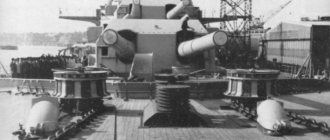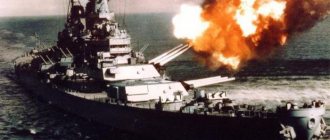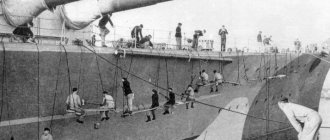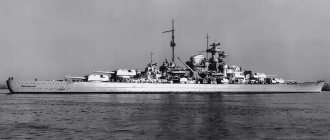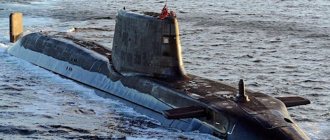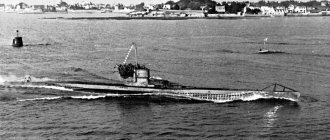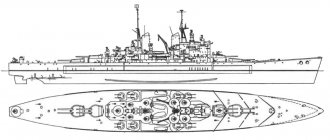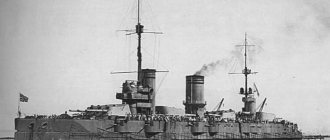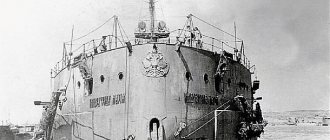Birth of a steel colossus
During the interwar period, Germany was one of the last in Europe to enter the naval arms race. The Anglo-German Agreement of 1935 broke the Versailles restrictions, allowing the Germans to build a fleet whose tonnage would not exceed 35% of the tonnage of the British Navy. This agreement triggered the rapid growth of the German Navy. In addition to the already ongoing construction of the Deutschland-class battleships, nicknamed “pocket battleships” by the English press, Germany laid down two modern battleships of the Scharnhorst class. True, these were rather battlecruisers - they could not compare with the battleships of the leading naval powers, being inferior to them in armor, armament and displacement.
The time for real battleships came for Germany in 1936, when the Bismarck was laid down in Hamburg, and a little later in Wilhelmshaven - its twin brother, the Tirpitz. These ships were well armored, carried eight 380-mm main caliber guns, had high speed and a displacement of over 40 thousand tons. Such a displacement was a violation of the 1936 London Treaty on the Limitation of Naval Arms. However, the Germans were not the only violators here, since the battleships of other countries born of this treaty also exceeded the established limit of 35 thousand tons.
At the beginning of World War II, both German giants had not yet entered service with the Kriegsmarine. Only on August 24, 1940, the flag of the German Navy was raised on the Bismarck, which meant the battleship was accepted into the fleet. A few weeks later, the ship left Hamburg for the first time, going on a training voyage. After this, a period of testing and crew training began for the Bismarck in the Baltic, which lasted until March 1941. Then the Kriegsmarine commander, Grand Admiral Erich Raeder, and his staff faced the question: how to use this steel giant?
Advantages and disadvantages of weaving
If we talk about the positive features of jewelry of this type, it is necessary to note the following:
- Appearance. A silver or gold Bismarck weave chain is quite massive, so it looks very expensive.
- Reliability. During the production of high-quality products, the links are woven and soldered, making the jewelry durable.
- A wide range of. For production, circles, ovals, rectangles made of flat or cylindrical wire are used. In addition, there are many weaving techniques, as well as the possibility of inlaying the finished product with precious stones and pearls.
- Good hold. Massive ligature requires a strong lock. In the production of such chains, high-strength carbines and springels are used.
- Duration of operation. Provided that high-quality materials are used and technology is followed, the finished product will last up to 50 years.
- Can be used with other accessories. Pendants, Orthodox and Catholic crosses, and medallions are hung on the decoration itself. It can also be combined with massive rings in your look.
- It is important to note that Bismarck gold and silver chains are made from high-grade precious metals, so they do not oxidize, do not leave green marks, etc.
Now it would be fair to note the disadvantages of such accessories. Firstly, weaving is not used in the manufacture of budget products. If the purchase amount is limited, it is better to look for other models. In addition, massive jewelry can overload the image, especially for young girls and boys.
View all “Double Bismarck” weaving chains in the SUNLIGHT catalog
From flagships to raiders
At the beginning of the war, the German Navy did not even think about pitched battles with the British fleet. The superiority of the British at sea was colossal, so the Kriegsmarine focused their attention on the most vulnerable point of the empire - its merchant shipping. From September 1939, the Germans began a tonnage war, trying to establish a blockade of the British Isles, destroying cargo ships going there. To do this, the Germans used all their forces and means, including submarines, aircraft, mines and surface raiders.
Why on the eve of World War II Britain was not ready to fight German submarines
The Kriegsmarine initially had no luck using large warships as hunters for "merchants" in the Atlantic. In December 1939, the Reich lost one of its raiders, the battleship Graf Spee. This “pocket battleship” was scuttled by its crew in the Uruguayan port of Montevideo after a battle with a squadron of British cruisers.
But Berlin did not abandon the idea of using its few cruisers and battleships as raiders. In the winter of 1940–1941, the battleship Admiral Scheer operated successfully in the Atlantic and Indian Ocean. In February 1941, the heavy cruiser Hipper destroyed the SLS-64 convoy. And the two-month raid of the battleships Scharnhorst and Gneisenau became truly triumphant - they sank two dozen ships.
The above successes played a cruel joke on Grand Admiral Raeder: he had the illusion that German ships could continue to operate in the Atlantic with impunity. As a result, Raeder decided to send the flagship of the German Navy, Bismarck, into cruising, without even waiting for its twin, Tirpitz, to finish testing.
The pride of the nation, the steel beast
By the time the ship was commissioned on August 24, 1940, the war had already turned the situation in Europe upside down, and the British, not the French, became Germany's main enemies at sea.
The German capture of Norway deprived the Royal Navy of strategic positions in the North Sea, and if the German battleships Scharnhorst and Gneisenau had managed to unite with Bismarck and Tirpitz, they would have formed a formidable force to confront the British. The “Battle of Britain” raged in the air, German submarines hunted the transports of the islanders in the Atlantic. If such a detachment had joined the blockade of sea supply routes, England would have been starved to death.
There were already interruptions in the food supply of the population, since German submarines, operating from French ports, sank more than 260 thousand tons of transport in August alone.
Bismarck guns
Alexey Kostenkov
The Germans were well aware that in the foreseeable future even super-battleships would not provide them with victory in an open battle with the Royal Navy - the British had too many battleships, aircraft carriers and naval aircraft. Therefore, all Kriegsmarine battleships were built taking into account actions as ocean raiders. In addition to their enormous range, they had to be able to evade slow-moving British battleships, and destroy battlecruisers of comparable speed thanks to their superior firepower and armor.
The raid of Scharnhorst and Gneisenau in early 1941 during Operation Berlin showed that German battleship raiders were quite capable of destroying Allied convoys, each time disappearing under the nose of the Royal Navy. The raid, which sent more than 115 thousand tons of cargo to the bottom, was personally led by Admiral Günther Lütjens, commander of the Kriegsmarine surface forces. In May 1941, he would lead the next operation on the newest Bismarck.
It was precisely the speedy blockade of Britain that German Admiral Erich Raeder was counting on when he gave command of the Bismarck to Admiral Gunther Lütjens. The senior mate was Ernst Lindemann. The team, consisting of more than 2,000 people, was selected from volunteers from all over Germany who had the highest qualifications. In the Baltic Sea, Bismarck conducted its first exercises, rehearsing a duel with the battle cruiser Hood. Built at the end of the Great War, Hood was long the flagship of the Royal Navy and the epitome of British sea power.
The first tests were successful. The Bismarck reached a speed of 30.8 knots, which allowed it to escape any threat.
Ernst Lindemann and the Bismarck team
There were only two drawbacks. Firstly, the recoil of the main caliber was too great, and fears arose that in a real battle it could damage the ship’s equipment. Secondly, the exercise simulating damage to the steering wheel failed. Without a rudder, the ship was practically unable to maneuver. However, rudders and propellers were the weak point of any ship. So the Admiralty ignored the second problem, deciding that the likelihood of the rudder failing was very small.
Alexey Kostenkov
In theory, it was possible to turn the ship by changing the direction of rotation of the propellers. But it turned out that in the case of the Bismarck, due to the peculiarities of its design, this practically does not work. Even turning on one side propeller to “full forward” and the second to “full backward”, the ship deviated only slightly.
By April 1941, Bismarck reached combat readiness. He had to return to the North Sea, meet there with the heavy cruiser Prinz Eugen and go to join the Gneisenau in the Atlantic. Raeder received orders to sink as many transports as possible within three months. The power of the Bismarck would allow the detachment to attack even guarded convoys. True, at that time both Gneisenau and Prinz Eugen were damaged and awaiting repairs.
Bismarck was waiting for them. On May 5, Adolf Hitler visited the ship. The Fuhrer loved warships, but did not have the slightest idea about naval tactics and strategy. He was wary of naval operations. On the one hand, I wanted to support the image of the power of the Kriegsmarine, inflated by propaganda, on the other, I did not want to irritate the neutral Americans and their fleet. So the fleet command did not let Hitler in on their plans.
Alexey Kostenkov
Admiral Lutyens believed that it was better to refrain from a second spring raid. At a meeting on April 26, he insisted that it was worth waiting for the Tirpitz to be ready, the Scharnhorst boilers to be repaired, and the Gneisenau to be repaired after being hit by a torpedo. And bring into the sea an already powerful strike force from four high-speed raider battleships, capable of sinking even a small British battle squadron if necessary.
Raeder agreed with these arguments, but said that it was necessary to combine the preservation of scarce battleships and pressure on British communications. Which, coupled with British defeats in Greece and Africa, gave a chance that London would sue for peace.
On May 5, Lutyens conveyed his opinion to Hitler. He hesitated, but never gave his sanction to cancel the operation. Naturally, Hitler was aware of the planning of the operation - taking the fleet flagship to sea secretly from the Fuhrer was unthinkable.
On the eighteenth of August, the Bismarck and the Prinz Eugen secretly set sail for the Atlantic. These two ships were powerful enough to cause serious damage to British communications. The British most likely knew that the Bismarck was ready for battle, but the Germans still tried to maintain secrecy. Before entering the ocean, the Bismarck could have fallen into a trap, where it would have been crushed by superior forces. However, exactly how the Kriegsmarine planned to keep the movements of the largest battleship in the world secret is completely unclear.
View of the Bismarck from the heavy cruiser Prinz Eugen
Alexey Kostenkov
Still, it is worth considering that the radars were imperfect, and in the vastness of the ocean, even a huge battleship was just a tiny sliver. In the case of the Bismarck - a very fast sliver. The British lost it already during the pursuit, and for the final attack they found it almost by accident.
It was not the movement of the battleship that prompted the British to think that the Germans were planning a raider breakthrough into the Atlantic, but the increased activity of German reconnaissance aircraft off Greenland and Jan Mayen. The British discovered the Bismarck and Prinz Eugen only in Bergen harbor.
On 20 August the Bismarck was discovered, and the next day members of the Norwegian resistance spotted German ships hiding in the fjords. They let the British know.
"Bismarck" in the ocean
Operation Rheinübung began on May 19, 1941, when the Bismarck left Gotenhafen under the flag of the surface fleet commander, Admiral Günther Lütjens. On the same day, another participant in the operation, the heavy cruiser Prinz Eugen, joined the flagship, after which this formation went to the Baltic Straits to enter the North Sea. But when it made its way through the narrowness of the Kattegat Strait, the German ships were noticed by a Swedish cruiser. He transmitted information to Stockholm, and from there information about German ships leaked to London. German intelligence quickly found out about this, but the Kriegsmarine command did not cancel the operation, although it was no longer secret.
Finale of the Battle of Norway: German battleships against the English aircraft carrier
The Admiralty was very concerned about the news they received. After all, the Bismarck was capable of fighting on equal terms with any British battleship. Its appearance in the Atlantic would mean that the German fleet had gone on the offensive, striking at Britain's sea communications. Therefore, the Admiralty threw all its efforts into finding and destroying the German steel giant.
Meanwhile, Lutyens' squadron entered Norway, and then went out to sea again to round Iceland from the north and enter the Atlantic through the Denmark Strait. But the British were guarding this route. On May 24, a battle between the Germans and the British squadron of Admiral Lancelot Holland took place here. Lutyens won the battle, sinking the battlecruiser Hood and damaging the battleship Prince of Wells. But during the battle, Bismarck also suffered. The British hits reduced its speed and deprived it of some fuel. In this situation, Lutyens had to set a course for France, sending the Prinz Eugen to continue cruising alone.
"Bismarck" during a battle with a British squadron in the Denmark Strait on May 24, 1941
German Federal Archives
What happened next is well known. For two days the British fleet pursued the Bismarck. To slow down the battleship, the British attacked it twice with torpedo bombers. On the evening of May 26, the battleship lost control when hit by torpedoes and died in a battle with the English squadron on the morning of May 27. But could events have developed differently?
The English aircraft carrier Ark Royal and its torpedo bombers, which played a fatal role in the fate of Bismarck
United Kingdom Government
Features of Bismarck weaving
There is no exact historical data about the origin of the technology. There is only a legend according to which one jeweler was impressed by the image of Otto von Bismarck. The master was delighted with the unbending will of the “iron chancellor” and against this background he developed a special chain of silver and gold chains.
The first wave of popularity awaited such products almost immediately after their invention. The jewelry was worn by the entire high society of the united Germany. Later, chains went out of fashion for almost a century, giving way to thin, elegant and fragile products.
In our country, women's and men's neck chains with Bismarck weave were especially popular in the 90s. The famous “finger-thick” products became a real symbol of the era. Now they are relevant again, largely due to their strength, reliability and long service life.
In the classical sense, jewelry is not a connection of rings, but an interweaving of pre-prepared spirals. Making a Bismarck chain begins with winding the wire and cutting it into fragments of the required length. The resulting elements are combined into a ligature and then sealed. Next, the product is cleaned, polished and decorated (blackened, diamond edges formed, etc.).
It may seem that jewelry produced using this technology is monotonous, but this is not so. Bismarck weaving is used for chains made of gold and silver; fragments and gaps can be of different sizes. In addition, there are more than 10 ways to use this technology.
Everyone get in line! The hunt has begun!
The death of Hood shocked the British. Admiral Tovey was ordered to devote all his forces to the destruction of the Bismarck. "Norfolk" and "Suffolk" were still watching the battleship, but could not detain it. The only ships close enough were Force H - Sheffield, Renown and the aircraft carrier Ark Royal with 18 Swordfish torpedo bombers on board. These biplanes looked outdated, but reached a speed of 100 knots - enough to overtake the Bismarck.
Lutyens was pessimistic - the entire British fleet was thundering at his heels. Force H intercepted Bismarck on 25 May, but Renown and Sheffield were too weak for open combat. At night, 15 torpedo bombers were sent to attack. These small planes were difficult to hit with anti-aircraft fire, especially in the dark, so they approached with desperate courage and dropped torpedoes at a range of 300 meters. The first hits caused only minor damage, but during an evasive maneuver the Bismarck was struck in the stern by a torpedo and its rudder was damaged. It was a blow to the battleship's Achilles heel.
Alexey Kostenkov
“Bismarck” was catastrophically unlucky in his only military campaign. There was simply no luck with “perfect” luck. He almost broke away from the pursuit, and was discovered by the Catalina only by chance among heavy clouds. The German battleship was already heading towards the French ports, the British ships had no chance of overtaking it, and the strike of 15 ancient biplanes from an aircraft carrier was a gesture of despair.
Lutyens was most afraid of British torpedo bombers - they caused critical damage. It was precisely the same rudder that was identified as the “Achilles heel” of the super-battleship. If all this happened in a movie or book; the author would have been laughed at for shamelessly playing along with the British. “This doesn’t happen in life.”
Evgeny Bashin-Razumovsky Expert on historical issues
I wouldn't attribute so much to bad luck. The British sent many ships and aircraft to catch the Bismarck - it’s not that incredible when scouts continuously patrolling the area “accidentally” found what they were looking for. The fact that a torpedo has a rudder crit on its dice - again, if a ship is attacked by torpedo bombers, it can hardly be called an incredible coincidence that one of them takes it and gets hit. Biplanes - well, yes, biplanes. Likewise, the Bismarck’s air defense, frankly, is not like that of the Iowa, and in addition, it is already hit and moving in splendid isolation without support. Shortly before the events described, Cunningham attacked the naval base in Taranto with the same biplanes and carried out a massacre there, despite the fact that in Taranto the Italians had not just one battleship, but a horde of warships, plus the base’s own anti-aircraft guns. So, with the pride of the German fleet, an iron law appears through chance - with such an inequality of forces and a qualified enemy, you can achieve beautiful tactical successes, but you won’t get two sixes forever.
"Ark Royal" and "Rinaun"
Repairers tried to find a way out of the situation, but the water pressure was too strong and did not allow people to be sent into the flooded steering compartment. The situation looked hopeless and the British were closing in. Admiral Lutyens radioed to Berlin: “The ship is out of action. We will fight until the last bullet. Long live the Fuhrer."
Tovey was going to attack the Bismarck from all sides - the battleships King George V and Rodney were supposed to enter the west, the Norfolk from the north, the heavy cruiser Dorsetshire from the east.
In the early morning of May 27, the slowly limping Bismarck was discovered. Rodney and King George V opened fire. Bismarck began to fire back, but soon two of its turrets were disabled. The shell hit the fire control post, killing the officers there - successful shots that decided the outcome of the battle. Bismarck went blind.
The shelling continued and by 09:15 the German battleship was a flaming wreck. He fired his last shots at 09:30, after which the last of the towers was destroyed.
Sinking Bismarck, Charles Eddowes Turner
Alexey Kostenkov
Under other conditions, the Bismarck would have inflicted significant damage to its opponents before its death - but in its last battle it had a constant deviation from course and a roll to the side, which made aiming difficult. The low speed and predictability of the course made it an ideal target. And 15 minutes after the start of the battle, the ship was overtaken by another “luck” - a shell from the British cruiser destroyed the main rangefinder.
The Bismarck was finished. Of the 2,876 shells fired at him, 400 reached their target, which took just over half an hour. The fight turned into a beating. The inside of the battleship was a hell of flames, asphyxiating gases, icy water, engine oil and the blood of the dying.
At 10:15, Lindemann—Lutjens was probably already dead by then—gave the order to abandon ship. The survivors tried to do so, but the shelling continued, killing hundreds of sailors. The final blow was three torpedoes from the Dorsetshire. At 10:40 "Bismarck" went under water. Only 115 people from his team survived.
Alexey Kostenkov
Wotan's strong steel and thoughtful design kept the ship afloat even when it was a twisted piece of metal. It was sent to the bottom only by the detonations of special charges by the crew, who received an order from the surviving officers to scuttle the battleship. Well, and British torpedoes to boot.
The surviving members of the Bismarck crew are lifted aboard the Dorsetshire (photo: IWM)
Hitler learned about what happened not from Admiral Raeder, but from British newspapers. The Kriegsmarine command was afraid to inform him about the tragedy. Thus ended the short-lived epic of the Bismarck, the most powerful of battleships. A big ship is, first of all, a big target.
